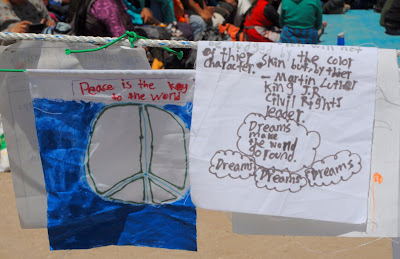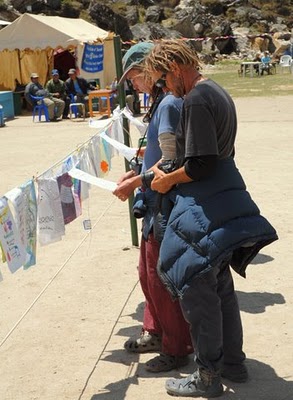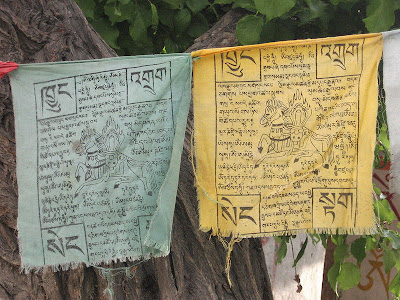Even in the kaleidoscopic pageantry of the Khumjung School Jubilee last May, the Dream Flags grabbed people's attention -- and their imagination.
Dream Flag Project display in the Khumjung schoolyard

A ropeline festooned with children's poems of their hopes and dreams inscribed on thousands of colorful cloth squares stretched hundreds of yards around the Khumjung schoolyard. Far out!


I talked to Jeff Harlan, who, along with a dozen collaborators, schlepped the flags to Khumjung. Harlan explained that he had initiated the Dream Flag Project with his sixth grade English classes at the non-sectarian all-girls Agnes Irwin School in suburban Philadelphia. Inspired by the "dream poetry" of Langston Hughes and the Buddhist use of prayer flags, the students wrote their own dream poems and painted them on cloth squares.

The Dream Thing
Dream, of course, is central to the American experience, and to the way the world views us. The American dream has been defined and redefined in American literature from Benjamin Franklin's Autobiography to Mark Twain's Huckleberry Finn to Arthur Miller's Death of a Salesman to the Mamas and the Papas' "California Dreaming."
Langston Hughes came along at a seminal moment, the Harlem Renaissance. His dream passes from personal to political. Here's the opening of "Freedom’s Plow":
When a man starts out with nothing,
When a man starts out with his hands
Empty, but clean,
When a man starts to build a world,
He starts first with himself
And the faith that is in his heart-
The strength there,
The will there to build.
First in the heart is the dream -
Then the mind starts seeking a way.
His eyes look out on the world,
On the great wooded world,
On the rich soil of the world,
On the rivers of the world.
Not all of Hughes' work is so sanguine. Here's "Dream Deferred":
What happens to a dream deferred?
Does it dry up
Like a raisin in the sun?
Or fester like a sore--
And then run?
Does it stink like rotten meat?
Or crust and sugar over--
like a syrupy sweet?
Maybe it just sags
like a heavy load.
Or does it explode?
Yes, that's the dream Lorraine Hansberry referred to in the title of her 1959 play, A Raisin in the Sun. And this is the dream tradition addressed by Martin Luther King, Jr. in his speech on the Washington Mall, and by Barack Obama in Dreams From My Father and The Audacity of Hope.
Dream in motion
Despite all the definition and redefinition, the American Dream isn't about everything. It isn't particularly about security, or victory, or winning the lottery, or life after death. It's not about piles of gifts under a Christmas tree, and, speaking as a vegetarian, I can assure you it isn't about a chicken in every pot.
Most basically, the dream is about freedom from bondage. Freedom from injustice, fear, diminished expectations, constrained development. It's freedom to move about, to pack up and leave, to write your own destiny. It's the freedom of the road -- not just the ribbon highway, but the car as well. This land is your land, sang Woodie Guthrie, and he meant the whole thing. Including the right to dream whatever you want, as long as you're willing to work for it, and to respect the legitimate dreams of your neighbors.
The Wind Horse
Like the dream theme, prayer flags travel well. In part that's because the flags are distinctively non-specific. Although they are associated with Tibetan Buddhism, they are as secular as any icon can be cultural context that is pervasively spiritual. It would be more accurate to use the Tibetan name for these flags, lung ta (wind horse), because the notion of prayer in Western traditions has vanishingly little to do with the flags' function.
Like much of the imagery of Tibetan religion, the flags derive from the shamanic Bön religion that Buddhism supplanted. Shamanism is a knowledge system focused largely on health and prosperity, not on theological doctrine. The shaman, or witch doctor, is a healer who mediates between this world and the impinging spirit world by ecstatic travel. Typically, the shaman will be asked to retrieve a missing beneficent spirit, which entails combat with demons and collaboration with friendly entities, both natural and supernatural. The shaman's oral account of these adventures, either while in trance or afterwards, is the medium by which the boon is shared with the patient or the community, and is considered to be the precursor of heroic epic and travel literature in general.
Prayer flag symbolism
The five primary colors are associated with the five elements of the cosmos, the domain in which we live, the abodes of those forces that shape our lives, and the limits of the shaman's travel. From top to bottom when the flags are displayed vertically, the colors are blue (sky/space), white (wind/air/cloud), red (fire), green (water), and yellow (earth). Indian Buddhist influence is seen in the blockprinted texts and imagery stamped on modern prayer flags. The text is generally a concatenation of mantras such as Om, mani pe-me hum!, usually translated as "Om! The jewel in the lotus," the jewel being dharma. The central image is usually the lung ta saddled with a large lotus-jewel; in the corners of the flag one often sees the four protectors: dragon, snow lion, tiger and garuda.

Tibetan Wind Horse. The words in large letters are the Tibetan words for the four protector animals; from upper left, clockwise: khyung (garuda), druk (dragon), tag (tiger), seng (lion). Photo courtesy of Wikipedia.
The wind horses are meant to be displayed outdoors, hung vertically on flag poles, in May-pole style from stupas, around gompas and other sacred places, and particularly around cairns on high mountain passes. Like prayer wheels, mani stones, and other outdoor mantra vehicles, the flags distribute good luck and merit to the winds. They also protect those who negotiate the trails, and the periodic or spontaneous placement of new lines of flags is a meaningful rite of passage.
An important aspect of the prayer flag is connectedness; as the flags are strung together, and the elements of our universe come together in each place, so individuals are linked in communities, and communities with each other. The connections are both meritorious and prophylactic.
Beyond all that, the prayer flag, like the dream flag, is an invitation to imagine. The lack of specific meaning gives free rein to metaphor. My own initial reaction to the Dream Flag Project was that it is a perfect enticement to travel. What better way to get kids off their butts than to have them travel halfway around the world and trek up to the Himalayas to share their flags with school children from distant lands? Here is a project to lift children's minds away from Hello Kitty and Spiderman, to interest them in geography and foreign languages, to mould wandering educators and diplomats instead of hedgefund managers and Walmart greeters.
Children? What children?
I was shocked-shocked to learn that, of the dozen or so psychopomps bringing dreamflags to Khumjung, the sum total of school children was exactly zero. Why? It seems that our State Department's travel advisory on Nepal makes it essentially impossible for schools to get insurance coverage for kids to travel there. It also tends to hamstring the efforts of study abroad programs like Cornell's, which for years has been tragically undersubscribed.
The US State Department's Travel Advisory is a model of understated hyperbole. Notwithstanding the end of armed conflict, there is continued concern about political unrest, assaults on lone trekkers, curfews, and blah blah blah blah blah. Anyone who read my column in July will concede that I am not given to whitewash, and I have certainly been inconvenienced by general strikes in Kathmandu. But the truth is that Nepal is safe. The people are nice. Foreigners are welcome. Out of millions of visitors, maybe a handful of trekkers have been murdered over the past decades; and there have been muggings by Maoists and other atrocities. But whatever has befallen tourists in Kathmandu in no way compares to the dangers of traveling in London, Rio de Janeiro, or Marseilles, much less New Orleans. In fact, a reasonable argument could be made that a child would be safer flying around the world to Khumjung than staying home and being driven in a limousine to a private school.

Imagine!
So, here's my dream: that the US State Department will one day stop feeding the paranoia and xenophobia of a country increasingly cut off from other countries. That Americans will wake up to the fact that we have less paid vacation time than any other "developed" country, that the two weeks most of us get is not enough to trek to Everest Base Camp even if we dare. That voters will realize that ignorance about foreign countries and exaggeration of perceived threats is what leads us to spend more than we can ever justify on "defense," while the Tea Party and big corporations purvey a new national creed of vicious incivility and greedy individualism.
That those who smirk along with Sarah Palin when she asks us, How's that hopey-changy thing working out for you? will remember what Langston Hughes foretold about "dreams deferred."
Maybe, in the breach, the Dream Flag Project can help by reminding us that this world is our world, and by taking our dreams on the road until the day comes when we can follow them.
Let's hope there's still enough audacity to keep those dreams alive.

Seth Sicroff, Nepal Editor for Wandering Educators
Manager, Sunrise Pashmina
All photos courtesy and copyright Seth Sicroff
